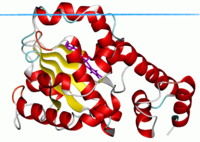CRAL-TRIO domain
| CRAL/TRIO domain | |||||||||
|---|---|---|---|---|---|---|---|---|---|
 Alpha-tocopherol transfer protein, closed state with ligand.[1] | |||||||||
| Identifiers | |||||||||
| Symbol | CRAL_TRIO | ||||||||
| Pfam | PF00650 | ||||||||
| InterPro | IPR001251 | ||||||||
| SMART | Sec14 | ||||||||
| SCOP2 | 1aua / SCOPe / SUPFAM | ||||||||
| OPM superfamily | 121 | ||||||||
| OPM protein | 1r5l | ||||||||
| CDD | cd00170 | ||||||||
| Membranome | 576 | ||||||||
| |||||||||
CRAL-TRIO domain is a protein structural domain that binds small lipophilic molecules.[2] This domain is named after cellular retinaldehyde-binding protein (CRALBP) and TRIO guanine exchange factor.
CRALB protein carries 11-cis-retinol or 11-cis-retinaldehyde. It modulates interaction of retinoids with visual cycle enzymes. TRIO is involved in coordinating actin remodeling, which is necessary for cell migration and growth.
Other members of the family are alpha-tocopherol transfer protein and phosphatidylinositol-transfer protein (Sec14). They transport their substrates (alpha-tocopherol and phosphatidylinositol or phosphatidylcholine, respectively) between different intracellular membranes. Family also include a guanine nucleotide exchange factor that may function as an effector of RAC1 small G-protein.
The N-terminal domain of yeast ECM25 protein has been identified as containing a lipid binding CRAL-TRIO domain.[3]
Structure
[edit]The Sec14 protein was the first CRAL-TRIO domain for which the structure was determined.[4] The structure contains several alpha helices as well as a beta sheet composed of 6 strands. Strands 2,3,4 and 5 form a parallel beta sheet with strands 1 and 6 being anti-parallel. The structure also identified a hydrophobic binding pocket for lipid binding.
Human proteins containing this domain
[edit]C20orf121; MOSPD2; PTPN9; RLBP1; RLBP1L1; RLBP1L2; SEC14L1; SEC14L2; SEC14L3; SEC14L4; TTPA; NF1;
References
[edit]- ^ Min KC, Kovall RA, Hendrickson WA (December 2003). "Crystal structure of human alpha-tocopherol transfer protein bound to its ligand: implications for ataxia with vitamin E deficiency". Proc. Natl. Acad. Sci. U.S.A. 100 (25): 14713–8. Bibcode:2003PNAS..10014713M. doi:10.1073/pnas.2136684100. PMC 299775. PMID 14657365.
- ^ Panagabko C, Morley S, Hernandez M, et al. (June 2003). "Ligand specificity in the CRAL-TRIO protein family". Biochemistry. 42 (21): 6467–74. doi:10.1021/bi034086v. PMID 12767229.
- ^ Gallego O, Betts MJ, Gvozdenovic-Jeremic J, et al. (November 2010). "A systematic screen for protein-lipid interactions in Saccharomyces cerevisiae". Mol. Syst. Biol. 6 (1): 430. doi:10.1038/msb.2010.87. PMC 3010107. PMID 21119626.
- ^ Sha B, Phillips SE, Bankaitis VA, Luo M (January 1998). "Crystal structure of the Saccharomyces cerevisiae phosphatidylinositol-transfer protein". Nature. 391 (6666): 506–10. Bibcode:1998Natur.391..506S. doi:10.1038/35179. PMID 9461221. S2CID 4416317.
External links
[edit]- UMich Orientation of Proteins in Membranes families/superfamily-129 - Calculated spatial positions of CRAL-TRIO domains in membrane
